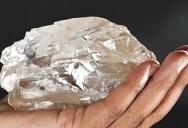World’s Second-Largest Diamond Discovered In Botswana And It’s A Whopping 2,492 Carats

Now that’s what I call a rock.
The world’s second-largest diamond was found recently, discovered in a mine in Botswana.
Weighing in at just over a pound, the 2,492 carat diamond was unearthed amongst kimberlite in the Karowe mine during operations by diamond exploration and mining company Lucara Diamond. The company used technology it developed called the Mega Diamond Recovery X-ray Transmission, or MDR XRT to discover the giant rock.
William Lamb, President and CEO of Lucara, said: “We are ecstatic about the recovery of this extraordinary 2,492 carat diamond. This find not only showcases the remarkable potential of our Karowe Mine, but also upholds our strategic investment in cutting-edge XRT technology. The ability to recover such a massive, high-quality stone intact demonstrates the effectiveness of our approach to diamond recovery and our commitment to maximizing value for our shareholders and stakeholders.”
Mr. Lamb added, “This discovery reinforces Karowe’s position as a truly world-class diamond mine and highlights the continued success of our operational and underground development strategy.”

Interestingly enough, this is not the first time the company has found the world’s second-largest diamond: Lucara uncovered both the 1,109 carat Lesedi La Rona and the 1,758 carat Sewelô that later knocked it off the second-place spot.
And while all three of those diamonds are impressive in their own right, they pale in comparison to the world’s largest gem: the Cullinan Diamond, which was unearthed in a South African mine back in 1905, and weighed a hefty 3,106 carats (621 grams).
That’s about the size and weight of an NBA basketball, for comparison.
That giant diamond and many others are generally broken up and used in (often royal) jewelry, cut into pieces to maximize profits. But giant diamonds can do more than just glint on the necks of the rich and famous; they can tell us a lot about the past, too.
For example, in a study published last year, 650- to 450-million-year-old “superdeep” diamonds mined from Brazil and Western Africa were analyzed in order to discover more about how the ancient supercontinent of Gondwana was formed.

Who knew that diamonds were more than just a girl’s best friend, but could possibly unlock the secrets of continent formation?
If you thought that was interesting, you might like to read a story that reveals Earth’s priciest precious metal isn’t gold or platinum and costs over $10,000 an ounce!

Sign up to get our BEST stories of the week straight to your inbox.




